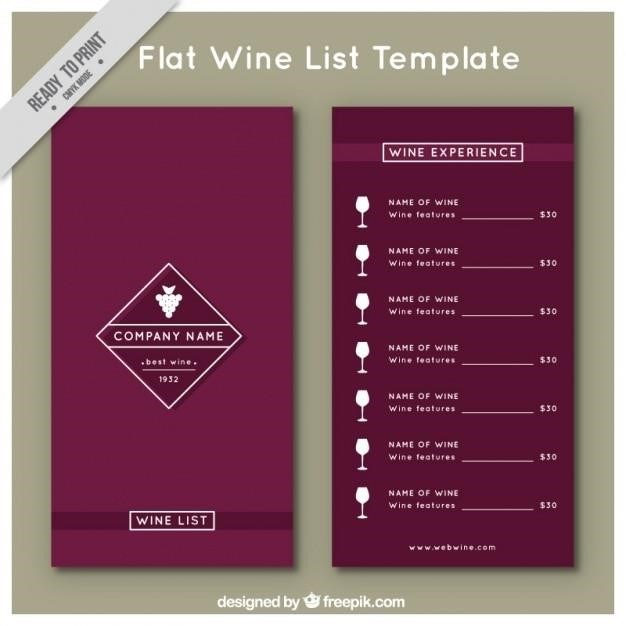Wine Name List A to Z PDF⁚ A Comprehensive Guide
This comprehensive guide provides an alphabetical list of wine names, encompassing both grape varieties and wine styles from around the world. Discover the diverse world of wine, from classic Cabernet Sauvignon to lesser-known regional specialties, all presented in a user-friendly PDF format for easy reference. This resource is perfect for wine enthusiasts, collectors, and those seeking to expand their knowledge of this fascinating beverage.
Wine Names Explained
The world of wine is filled with a captivating tapestry of names, each carrying a story of origin, tradition, and flavor. Understanding these names is essential for navigating the vast landscape of wine choices. Wine names can be categorized into several key types, each offering a unique glimpse into the wine’s identity.
Varietal Names⁚ These are the most common type of wine name and simply refer to the primary grape used in the wine. Examples include Chardonnay, Pinot Noir, and Sauvignon Blanc. Varietal wines allow consumers to focus on the inherent characteristics of specific grapes, such as the crisp acidity of Sauvignon Blanc or the rich, earthy notes of Pinot Noir.
Regional Names⁚ These wines take their names from the geographical area where the grapes are grown and the wine is produced. Bordeaux, Champagne, and Chianti are classic examples. Regional names often evoke a sense of place and terroir, highlighting the unique influence of soil, climate, and local winemaking traditions.
Style Names⁚ These names describe the wine’s overall character, sweetness level, or production method. Examples include Riesling, Pinot Grigio, and Zinfandel. Style names can be helpful for those seeking wines with specific flavor profiles, such as the dry, crisp taste of a Riesling or the full-bodied, fruit-forward character of a Zinfandel.
Blend Names⁚ These wines are a combination of different grape varieties. Bordeaux blends, for instance, often combine Cabernet Sauvignon, Merlot, and Cabernet Franc. Blend names allow winemakers to create complex wines with unique flavor profiles that transcend the characteristics of a single grape.
Understanding these different types of wine names is the first step towards becoming a more confident and informed wine consumer. With a little exploration, you can delve into the world of wine and discover the fascinating stories behind each bottle.
Types of Wine⁚ A-Z
The world of wine is a vast and diverse landscape, offering a spectrum of flavors and styles to suit every palate. From the light and refreshing to the bold and complex, there’s a type of wine for every occasion. Here’s a comprehensive A-Z guide to the most common types of wine, providing a glimpse into their defining characteristics and flavor profiles.
- Cabernet Sauvignon⁚ Known for its bold, full-bodied structure and rich flavors of black currant, cassis, and cedar.
- Chardonnay⁚ A versatile white wine with a wide range of styles, from crisp and refreshing to buttery and oaky, often exhibiting flavors of apple, pear, and citrus.
- Merlot⁚ A medium-bodied red wine with smooth tannins and flavors of plum, cherry, and chocolate.
- Pinot Noir⁚ A delicate and elegant red wine known for its light body, earthy flavors of cherry, raspberry, and spice, and often a hint of mushroom.
- Riesling⁚ A white wine with a wide range of sweetness levels, from bone-dry to intensely sweet, often exhibiting flavors of citrus, apple, and honey.
- Sauvignon Blanc⁚ A crisp and refreshing white wine with zesty flavors of grapefruit, lime, and green apple, often accompanied by herbaceous notes.
- Syrah/Shiraz⁚ A bold red wine with intense flavors of black pepper, blackberry, and licorice, often exhibiting notes of leather and earth.
- Zinfandel⁚ A fruity and full-bodied red wine with vibrant flavors of jammy blackberries, raspberries, and spices.
This is just a starting point for exploring the vast world of wine types. Each region and winemaker brings its own unique spin to these classic styles, creating a truly diverse and exciting landscape of flavors to discover;
Wine Varietals⁚ A Comprehensive List
The heart of any wine is the grape varietal from which it’s crafted. This comprehensive list explores the diverse world of wine grapes, offering a glimpse into their unique characteristics and the styles of wines they produce. From the familiar Cabernet Sauvignon to lesser-known gems, this list provides a foundation for understanding the vast spectrum of flavors and aromas in the wine world.

- Aligoté⁚ A white grape varietal known for its crisp acidity and refreshing flavors of green apple and lemon, often used for dry white wines.
- Cabernet Franc⁚ A red grape varietal known for its vibrant acidity and aromas of black cherry, cassis, and bell pepper, often blended with Cabernet Sauvignon to add complexity.
- Chenin Blanc⁚ A versatile white grape varietal known for its high acidity and flavors of apple, pear, and honey, capable of producing both dry and sweet wines.
- Grenache⁚ A red grape varietal known for its full-bodied structure and rich flavors of red fruit, spice, and earth, often used in blends.
- Malbec⁚ A red grape varietal known for its intense color, bold tannins, and flavors of plum, blackberry, and spice, particularly popular in Argentina.
- Merlot⁚ A red grape varietal known for its smooth tannins and flavors of plum, cherry, and chocolate, often producing wines with a velvety texture.
- Pinot Grigio/Pinot Gris⁚ A white grape varietal known for its crisp acidity and flavors of pear, apple, and citrus, often used for dry white wines.
- Sangiovese⁚ A red grape varietal known for its high acidity and flavors of cherry, plum, and leather, often producing wines with a rustic character.
- Tempranillo⁚ A red grape varietal known for its full-bodied structure and flavors of blackberry, plum, and tobacco, particularly popular in Spain.
- Viognier⁚ A white grape varietal known for its aromatic profile and flavors of apricot, peach, and floral notes, often used for full-bodied white wines.
This list is a starting point for delving into the fascinating world of wine grapes. Each varietal has its own unique story and nuances, contributing to the incredible diversity and complexity of wines around the globe.
Wine Regions⁚ A Global Exploration
The world of wine is a tapestry woven from diverse landscapes, each contributing unique characteristics to the wines they produce. This section embarks on a global exploration of renowned wine regions, highlighting their distinctive terroirs, grape varieties, and the styles of wines they are famous for. From the rolling hills of Tuscany to the sun-drenched vineyards of California, each region possesses its own unique story, reflected in the wines that emerge from its soil.
- Bordeaux, France⁚ A historic wine region known for its Cabernet Sauvignon and Merlot-based red wines, characterized by their elegant structure and aging potential. Notable appellations include Saint-Émilion, Pauillac, and Margaux.
- Burgundy, France⁚ A region revered for its Pinot Noir and Chardonnay wines, celebrated for their finesse, complexity, and terroir-driven character. Renowned appellations include Chablis, Côte de Nuits, and Côte de Beaune.
- Champagne, France⁚ The birthplace of sparkling wine, Champagne is renowned for its méthode champenoise production method and the elegant, bubbly wines it produces.
- Tuscany, Italy⁚ A region known for its Sangiovese-based red wines, including Chianti and Brunello di Montalcino, characterized by their vibrant acidity and earthy flavors.
- Piedmont, Italy⁚ A region renowned for its Nebbiolo-based wines, including Barolo and Barbaresco, known for their intense tannins and complex aromas of roses, tar, and truffles.
- Rioja, Spain⁚ A region known for its Tempranillo-based red wines, characterized by their aging potential and flavors of red fruit, spice, and vanilla.
- Napa Valley, California⁚ A renowned wine region in the United States, known for its Cabernet Sauvignon-based red wines, Cabernet Franc, and Zinfandel, often showcasing bold fruit and oak.
- Barossa Valley, Australia⁚ A region known for its Shiraz-based red wines, characterized by their full-bodied structure and intense fruit flavors.
- Marlborough, New Zealand⁚ A region renowned for its Sauvignon Blanc wines, known for their vibrant acidity and aromas of citrus, passionfruit, and gooseberry.
This global exploration serves as a starting point for discovering the diverse wines produced around the world. Each region has its own unique characteristics, making the world of wine a fascinating journey of discovery.
Wine Styles⁚ From Dry to Sweet
The spectrum of wine styles encompasses a diverse array of flavors and textures, ranging from bone-dry to lusciously sweet. Understanding these styles allows you to navigate the world of wine with greater confidence, selecting wines that complement your personal preferences and culinary pairings. This section delves into the key wine styles, exploring their defining characteristics and the grape varieties often associated with them.
- Dry Wines⁚ These wines are characterized by a complete absence of residual sugar, meaning all the sugar in the grapes has been converted to alcohol during fermentation. Dry wines typically have a crisp, clean finish and are often paired with savory dishes.
- Semi-Dry Wines⁚ These wines contain a small amount of residual sugar, resulting in a slightly sweeter taste. Semi-dry wines offer a balance of sweetness and acidity, making them versatile pairings for various dishes.
- Off-Dry Wines⁚ These wines possess a noticeable sweetness, often with a perceptible balance of acidity. Off-dry wines are enjoyed for their fruit-forward flavors and can be paired with both sweet and savory dishes.
- Sweet Wines⁚ These wines have a significant amount of residual sugar, resulting in a pronounced sweetness. Sweet wines are often made from grapes with high sugar content or through techniques that preserve sweetness during fermentation. They are typically enjoyed as dessert wines or paired with rich desserts.
- Sparkling Wines⁚ These wines are characterized by their effervescence, created by the addition of carbon dioxide. Sparkling wines range in sweetness levels, from dry to sweet, and are known for their celebratory nature.
- Fortified Wines⁚ These wines have had alcohol added to them during or after fermentation, resulting in a higher alcohol content and often a sweeter taste. Fortified wines are often aged in oak barrels and can be enjoyed as aperitifs or alongside desserts.
This spectrum of wine styles highlights the diverse range of flavors and textures that wine offers. Exploring these styles allows you to expand your palate and discover new favorites within the vast world of wine.
Wine Glossary⁚ Essential Terms
Navigating the world of wine can be a delightful journey, but it can also be filled with unfamiliar terms. This glossary provides definitions for essential wine terms, empowering you to confidently discuss and understand wine like a seasoned connoisseur. From basic concepts to nuanced tasting notes, this glossary serves as your guide to decoding the language of wine.
- Aromas⁚ The scents perceived in wine, often described using evocative terms like fruit, spice, floral, or earthy. These aromas can be derived from the grapes, the winemaking process, or aging in oak barrels.
- Body⁚ The perceived weight or fullness of a wine in the mouth. Wines can be described as light-bodied, medium-bodied, or full-bodied, depending on their intensity and concentration of flavor.
- Tannins⁚ Compounds found in grape skins, seeds, and stems that contribute to a wine’s structure, astringency, and aging potential. Tannins can create a drying sensation on the palate and often develop complexity over time.
- Acidity⁚ The tartness or sharpness in a wine, often described as citrusy, refreshing, or lively. Acidity plays a crucial role in balancing sweetness, enhancing flavors, and contributing to a wine’s longevity.
- Oak⁚ The wood used to make barrels for aging wine. Oak imparts flavors and aromas to the wine, such as vanilla, spice, and toasty notes. The type of oak, its toasting level, and the aging time all influence the final flavor profile.
- Vintage⁚ The year the grapes were harvested. Vintage is crucial for understanding a wine’s character, as weather conditions can significantly impact the grapes’ quality and flavor development.
- Terroir⁚ The unique combination of soil, climate, and geographical factors that influence the character of a wine. Terroir is often used to describe the distinctive qualities of wines produced in specific regions.
With this glossary as your companion, you’ll be well-equipped to navigate the fascinating world of wine with confidence and appreciation.
Famous Wine Names⁚ A-Z
The world of wine boasts a constellation of famous names, each representing a legacy of quality, tradition, and often, a captivating story. This alphabetical list highlights some of the most celebrated wines, showcasing their regions of origin and the qualities that have earned them global recognition.
- Chateau Lafite Rothschild (Bordeaux, France)⁚ A First Growth Bordeaux, renowned for its powerful, age-worthy Cabernet Sauvignon-based wines. Known for its structure, elegance, and ability to age gracefully for decades.
- Dom Pérignon (Champagne, France)⁚ A prestige cuvée of Champagne, crafted from the finest Chardonnay and Pinot Noir grapes. Celebrated for its complex aromas, fine bubbles, and exceptional aging potential.
- Penfolds Grange (South Australia, Australia)⁚ A legendary Australian Shiraz, known for its intense fruit, powerful tannins, and exceptional aging potential. Often described as a “cult wine,” commanding high prices and garnering international acclaim.
- Robert Mondavi (Napa Valley, California)⁚ A pioneer of American winemaking, Robert Mondavi established a legacy of producing high-quality Cabernet Sauvignon and Chardonnay wines in Napa Valley.
- Sassicaia (Tuscany, Italy)⁚ A Super Tuscan wine made predominantly from Cabernet Sauvignon. Known for its rich, complex flavors, elegant structure, and ability to age gracefully.
- Screaming Eagle (Napa Valley, California)⁚ A highly sought-after Cabernet Sauvignon from Napa Valley, renowned for its opulent fruit, intense tannins, and exceptional quality.
- Vega Sicilia Único (Ribera del Duero, Spain)⁚ A Spanish red wine made from Tempranillo, known for its intense fruit, complex flavors, and exceptional aging potential. Often considered one of Spain’s finest wines.
This list serves as a starting point for exploring the world of renowned wines. Each name represents a unique story, a testament to the passion and artistry of winemakers, and a journey into the world of exceptional wine experiences.



Leave a Reply
You must be logged in to post a comment.